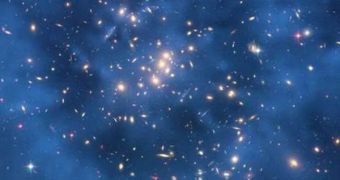Researchers working at the Coherent Germanium Neutrino Technology (CoGeNT) experiment – deep underground in a Minnesota mine – say that they may have found additional evidence on the existence of hypothesized, long-sought-for dark matter.
A team in Italy has been reporting on seasonal variations in the particles they discover for 10 years now, but their results have yet to be confirmed by other team. The readings collected by the CoGeNT team working in the Soudan Mine might be the first to confirm these studies.
Located more than half a mile underground, the Soudan experiment is looking for signs of dark matter, the hypothesized stuff believed to make up nearly a quarter of the mass of the Universe. Normal, baryonic matter accounts for only 4 percent of all the cosmic mass.
The leading candidate for dark matter are weakly-interacting massive particles (WIMP), which the Italian team says it found. The Soudan team is now looking to discern whether WIMP can actually be teased out from natural sources of radiation or not.
CoGeNT investigators say that their detector has found a seasonal signal variation that appears to be in tune with the one reported by the Italian team. Furthermore, the signal meets the theoretical predictions of how dark matter would behave like, if it was made up of WIMP.
“We cannot call this a WIMP signal. It’s just what you might expect from it,” explains University of Chigao associate professor of physics Juan Collar. He and Pacific Northwest National Laboratory (PNNL) expert John Orrell lead the CoGeNT collaboration.
Collar believes that the new readings can be explained in one of two scenarios. Either they are produced by WIMP making up dark matter, or they are just a random fluctuations. In the latter case, the signal may be produced by some new, exotic phenomenon in particle physics.
Thus far, the existence of dark matter has only been determined through the effects it has on baryonic matter. It is believed that massive amounts of the stuff exist in galaxies, accounting for the cosmic structures' massive gravitational pull.
In the vast majority of cases, the pull cannot be accounted for by the presence of normal matter alone. In other words, there is insufficient visible mass in galaxies to explain their gravitational pull.
The CoGeNT collaboration appears to have detected one WIMP interaction per month, during its 15 months of operation. WIMP are believed to be their own antimatter particles. When two such particles meet, they annihilate each other, producing signals that are theoretically detectable.
Calculations conducted at the particle experiment have found that there's a half a percent chance that the findings are a fluke in the detector itself. “It’s not an exact science yet, unfortunately,” Collar says.
“But with the information we have, the usual set of assumptions that we make about the halo and these particles, their behavior in this halo, things seem to be what you would expect,” he concludes, quoted by Daily Galaxy.

 14 DAY TRIAL //
14 DAY TRIAL //